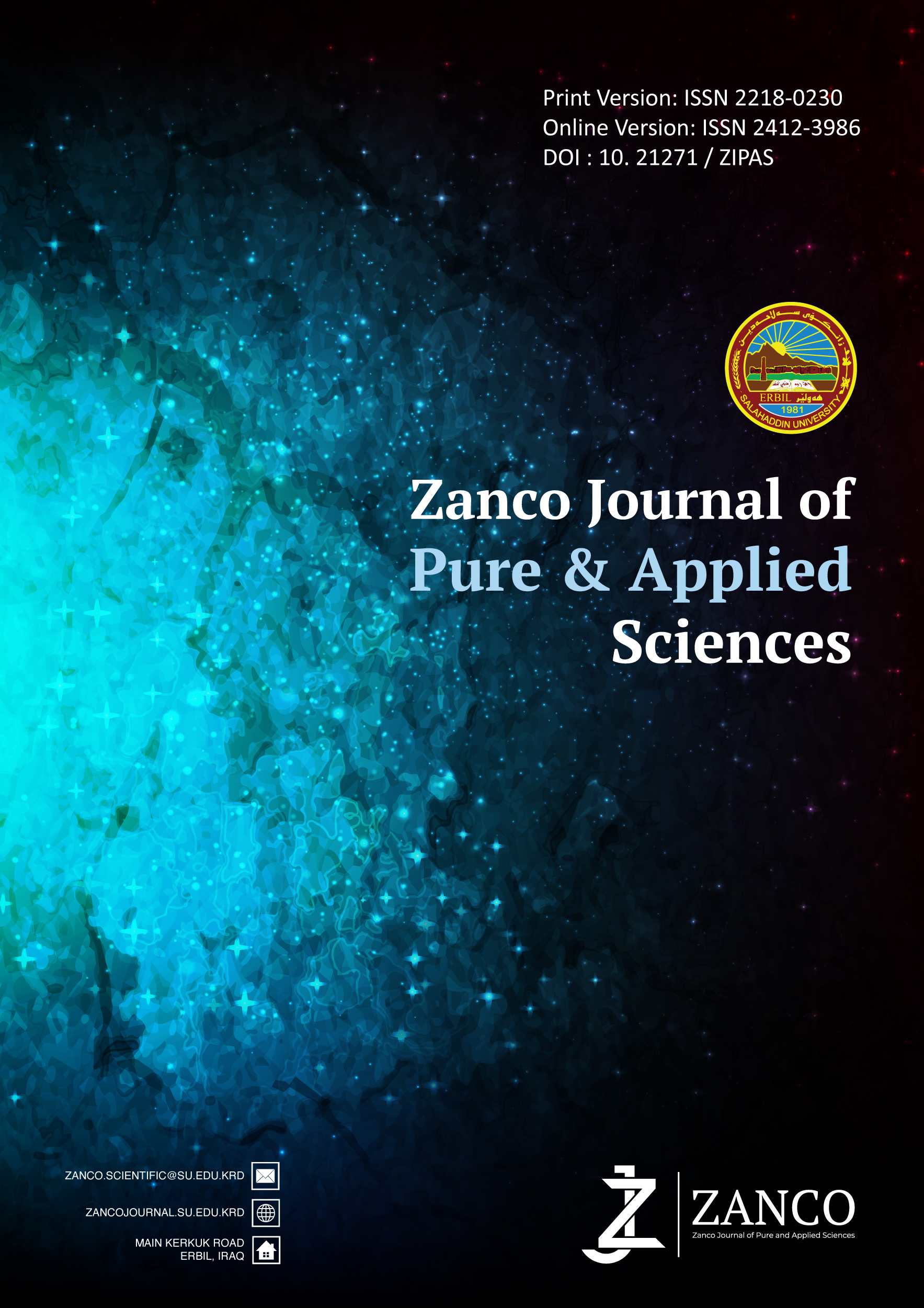Effect of Organic Fertilizer on Growth and Physiology of Brachychiton populneus (Schott& Endl) Seedlings under Drought Conditions
DOI:
https://doi.org/10.21271/ZJPAS.36.6.10Keywords:
Kurrajong , tolerance, chlorophyll , drought stress, organic fertilizerAbstract
Drought stress negatively impacts plant growth and agricultural productivity. This study investigates whether organic fertilizer can mitigate these effects by improving the growth and physiological responses of Brachychiton populneus seedlings under drought conditions. Thus, local compost added to Brachychiton populneus (Schott & Endl) to determine whether it could aid the growth of the seedlings during drought conditions. Two drought stress levels (D1 and D2), or 60% and 30% of the soil water holding capacities (SWHC%), were applied to the seedlings compared to the control (C0). There were two additions of local compost (C1 and C2), 2000 and 4000 ppm, respectively, in comparison to the control treatments. D1C2 (soil water holding capacity of 60% and 4000 ppm compost) was the usual treatment combination. Which resulted in the longest shoot and root lengths. By registering the maximum dry matter content in the roots and shoots, the same combination also greatly increased the biomass of the seedlings. A general decline in the relative water content appears when biomass increases. The consequences of drought stress are lessened by the addition of compost, which also improves chlorophyll production and overall plant growth. Growth and physiological parameter correlations are shown by the component plot in rotated space. The highest variance is explained by component 1, and the second largest by component 2. A positive association was seen between root length, shoot height, and total dry weight, as they clustered together. Conversely, there is a negative association observed between the components of relative water content and shoot dry weight. However, component 2 and the leaf chlorophyll content (a, b, and total) showed a significant correlation. Compost provides a sustainable solution for improving drought resilience in Brachychiton populneus, making them crucial for forest nurseries and reforestation efforts in arid and semi-arid regions.
References
Abdelrasheed, K.G., Mazrou, Y., Omara, A.E.D., Osman, H.S., Nehela, Y., Hafez, E.M., Rady, A.M., El-Moneim, D.A., Alowaiesh, B.F. and Gowayed, S.M. (2021). Soil amendment using biochar and application of K-humate enhance the growth, productivity, and nutritional value of onion (Allium cepa L.) under deficit irrigation conditions. Plants, 10(12), p.2598.
Anderson, E. (2016). Plants of Central Queensland: Identification and Uses of Native and Introduced Species. CSIRO Publishing, 576pp.
Baldi, E., Toselli, M., Marcolini, G. and Marangoni, B. (2005), January. Effect of mineral and organic fertilization on soil chemical, biological and physical fertility in a commercial Peach orchard. In V International Symposium on Mineral Nutrition of Fruit Plants 721 (pp. 55-62).
Beeson, R.J., 2006. Relationship of plant growth and actual evapotranspiration to irrigation frequency based on management allowed deficits for container nursery stock. Journal of the American Society for Horticultural Science, 131(1), 140-148.
Choat, B., Jansen, S., Brodribb, T.J., Cochard, H, Delzon, S., Bhaskar, R. & Jacobsen, A.L. (2012). Global convergence in the vulnerability of forests to drought. Nature, 491: 752-755. https://doi.org/10.1038/nature11688 da Silva, E.C., Nogueira, R.J.M.C., da Silva, M.A. and de Albuquerque, M.B. (2011). Drought stress and plant nutrition. Plant Stress, 5(1), pp.32-41. http://globalsciencebooks.info/Online/GSBOnline/images/2011/PS_5SI1/PS_5(SI1)32-41o.pdf
Dimkpa, C.O., Andrews, J., Sanabria, J., Bindraban, P.S., Singh, U., Elmer, W.H., Gardea-Torresdey, J.L. and White, J.C. (2020). Interactive effects of drought, organic fertilizer, and zinc oxide nanoscale and bulk particles on wheat performance and grain nutrient accumulation. Science of the Total Environment, 722, p.137808.
Dos Santos, T.B., Ribas, A.F., de Souza, S.G.H., Budzinski, I.G.F. and Domingues, D.S. (2022). Physiological responses to drought, salinity, and heat stress in plants: a review. Stresses, 2(1), pp.113-135.
Enquist, B. J., Niklas, K. J. (2002). Global allocation rules for patterns of biomass partitioning in seed plants. Science 295 (5559), 1517–1520.
Hale, L., Curtis, D., Azeem, M., Montgomery, J., Crowley, D.E. and McGiffen Jr, M.E. (2021). Influence of compost and biochar on soil biological properties under turfgrass supplied deficit irrigation. Applied Soil Ecology, 168, p.104134.
Han, G., Liang, C.Z., Chung, T.S., Weber, M., Staudt, C. and Maletzko, C. (2016). Combination of forward osmosis (FO) process with coagulation/flocculation (CF) for potential treatment of textile wastewater. Water Research, 91, pp.361-370.
Horii, A., McCue, P. and Shetty, K. (2007). Seed vigour studies in corn, soybean and tomato in response to fish protein hydrolysates and consequences on phenolic-linked responses. Bioresource Technology, 98(11), pp.2170 2177.
Kammann, C.I., Linsel, S., Gößling, J.W. and Koyro, H.W. (2011). Influence of biochar on drought tolerance of Chenopodium quinoa Willd and on soil–plant relations. Plant and Soil, 345, pp.195-210.
Karim, S. A., Qadir, S. A., & Sabr, H. A. (2020). Study some of morphological and physiological traits of Kurrajong Brachychiton populneus (Schott & Endl.) seedlings planted under water stress conditions. Basrah Journal of Agricultural Sciences, 33, 213–220.
Khatun, R., Uddin, M.I., Uddin, M.M., Howlader, M.T.H. and Haque, M.S. (2022). Analysis of qualitative and quantitative morphological traits related to yield in country bean (Lablab purpureus L. sweet) genotypes. Heliyon, 8(12).
Kowaljow, E., Gonzalez-Polo, M. and Mazzarino, M.J., 2017. Understanding compost effects on water availability in a degraded sandy soil of Patagonia. Environmental Earth Sciences, 76(6), p.255.
Muhammad, M.Q., Khursheed, M.Q. and Qadir, S.A. (2023). Response of Some Bread Wheat Genotypes (Triticum aestivum L.) to Salinity at Early Growth Stage. Zanco Journal of Pure and Applied Sciences, 35(2), pp.173-180.
Ortiz, J.C.R. (2020). Nutritive Solutions Formulated from Organic Fertilizers. Urban Horticulture, p.75.
Paliwal, K., Karunaichamy, K.S.T.K. and Ananthavalli, M. (1998). Effect of sewage water irrigation on growth performance, biomass and nutrient accumulation in Hardwickia binata under nursery conditions. Bioresource Technology, 66(2), pp.105-111.
Przywara, M., Przywara, R., Zapała, W. and Opaliński, I. (2023). Mechanical properties of solid biomass as affected by moisture content. AgriEngineering, 5(3), pp.1118-1135.
Qadir, S.A.; Khursheed, M.Q. and Huyop, F.Z. (2017). Drought tolerance and genetic diversity among selected wheat cultivars. ZANCO Journal of Pure and Applied Sciences, 29(3): 110-117.
Qadir, S.A.; Khursheed, M.Q. & Huyop, F.Z. (2016). Effect of drought stress on morphology, growth and yield of six bread wheat (Triticum aestivum L.) cultivars. ZANCO J. Pure Appl. Sci., 28(3): 37-48.
Rehman, S.U., De Castro, F., Aprile, A., Benedetti, M. and Fanizzi, F.P. (2023). Vermicompost: Enhancing plant growth and combating abiotic and biotic stress. Agronomy, 13(4), p.1134.
Shaji, H., Chandran, V. and Mathew, L. (2021). Organic fertilizers as a route to controlled release of nutrients. In Controlled Release Fertilizers for Sustainable Agriculture (pp. 231-245). Academic Press.
Smart, R.E. and Bingham, G.E. (1974). Rapid estimates of relative water content. Plant physiology, 53(2), pp.258-260.
Statistics IS. IBM Corp. Released (2013). IBM SPSS Statistics for Windows, Version 22.0. Armonk, NY: IBM Corp. Google Search. 2013. https://scholar.google.com/scholar?cluster=13152762729471798258&hl=en&as_sdt=2005&sciodt=0,5
Sulaiman Rashid T.; Kazm Mahmud, K.; Kakakhan Awla, H., and Anwar Qadir, S. (2024). Tomato Seed Treatment and Germination Responses to Selected Plant Extracts. Journal of Crop Health, 76(5), 1137-1146.
Taiz, L., Zeiger, E., Møller, I.M. and Murphy, A. (2015). Plant physiology and Development.
Tanure, M.M.C., da Costa, L.M., Huiz, H.A., Fernandes, R.B.A., Cecon, P.R., Junior, J.D.P. and da Luz, J.M.R. (2019). Soil water retention, physiological characteristics, and growth of maize plants in response to biochar application to soil. Soil and Tillage Research, 192, pp.164-173.
Ullah, I., Tariq, M. and Sharif, M. (2023). Comparative Effect of Organic and Inorganic Fertilizers On Improving Soil Fertility and Productivity of Different Legumes Under Alkaline Calcareous Soil. Gesunde Pflanzen, 75(2), pp.361-376.
Wander, M. (2004). Soil organic matter fractions and their relevance to soil function. Soil organic matter in sustainable agriculture. CRC Press, Boca Raton, FL, pp.67-102. https://www.routledge.com/Advances-in-Agroecology/book-series/CRCADVAGROECO
Yan, S., Weng, B., Jing, L. and Bi, W. (2023). Effects of drought stress on water content and biomass distribution in summer maize (Zea mays L.). Frontiers in Plant Science, 14, p.1118131.
Yang, X., Lu, M., Wang, Y., Wang, Y., Liu, Z. and Chen, S. (2021). Response mechanism of plants to drought stress. Horticulturae, 7(3), p.50.
Zgallai, H., Zoghlami, R.I., Annabi, M., Zarrouk, O., Jellali, S. and Hamdi, H. (2024). Mitigating soil water deficit using organic waste compost and commercial water retainer: a comparative study under semiarid conditions. Euro-Mediterranean Journal for Environmental Integration, 9(1), pp. 377-391.
Downloads
Published
How to Cite
Issue
Section
License
Copyright (c) 2024 Shaymaa Hani Mahmood, Sirwa Anwar Qadir, Evan Anaeat Mohammed, Chnar Najmaddin Fathulla, Aven Alaalddin Ahmed

This work is licensed under a Creative Commons Attribution 4.0 International License.














